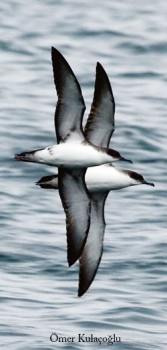Sylvia Zakkak (Department of Ecology, Aristotle University of Thessaloniki, Greece) and colleagues write in the open-access journal Marine Ornithologyon at-sea densities and extrapolated numbers of Scopoli’s Calonectris diomedea and Yelkouan Puffinus yelkouan Shearwaters (both potential candidates for ACAP listing) in the Aegean Sea.
The paper’s abstract follows:
“We estimate the population size of the three most abundant seabird species in the north Aegean Sea (Calonectris diomedea, Larus michahellis and Puffinus yelkouan), along with their distribution patterns. Sampling was carried out from May to September 2009 in line transects 300 m or 600 m wide and with a total length of 3 007 km. The sampling was opportunistic, using a variety of ships. After the data were corrected for movement bias, populations were estimated by using two types of stratification method: novel fractal–based method as well as generalized additive models, which yielded the most conservative estimate of the population, although all estimates were quite similar. Overall, taking the mean estimate of the three most credible methods, we estimate the density of birds for the area to be 0.46 birds/km² for the three species together (C. diomedea 0.10 birds/km², L. michahellis 0.11 birds/km² and P. yelkouan 0.26 birds/km²). These densities of seabirds in the north Aegean are smaller than observed in studies in other parts of the world, but not surprisingly so, given the low productivity of the north Aegean. In view of the widespread and growing threats to seabird populations, the results of this study provide a useful basis for further scientific studies and for applied research including the designation of marine Important Bird Areas for the region.”

Yelkouan Shearwaters at sea
Reference:
Zakkak, S., Panagiotopoulou, M., & Halley, J.M. 2013. Estimating the abundance of seabirds in the north Aegean Sea. Marine Ornithology 41: 141-148.
John Cooper, ACAP Information Officer, 23 March 2014

 English
English  Français
Français  Español
Español